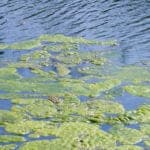During the summer months, when the weather is hottest, news of algae blooms throughout Florida can make the news. For a commercial property, it’s important not to confuse blue-green algae, that has closed local beaches in areas such as Palm Beach, Martin, and St Lucie counties, with other algae that reoccurs during the summer months. There’s also hydrilla, which is prevalent when the lakes are low. Hydrilla can look like algae, but is actually an aquatic plant.
To combat algae blooms and other water issues, we recommend “best landscaping practices,” which plays a big part in the maintenance of the lakes. One of the biggest issues at local lakes, with regard to management practices for landscaping, is the fact that every homeowner, as well as many condo associations, maintain their own lawns. This means they fertilizes whenever they want, with whatever fertilizer they choose, which creates an uncontrollable situation. Many don’t realize that, after fertilizing with the wrong product, in excess and too close to the lake’s edge, a lot of it washes into the lake once the sprinklers come on or it rains. In addition, they may blow their grass clippings into the lake or the storm drains, where the clippings decompose and release a fresh batch of algae feeding nutrients.
Since algae production is a direct result of the amount of nutrients entering the water, the only way to minimize the amount of algae is thru best management practice for landscaping. These include the following:
- Fertilizers should not be applied closer than 15’ (feet) to the lake’s edge.
- Fertilizer with a zero-phosphorus count should be used (Florida soil is already rich with phosphorus).
- When mowing the lawn, grass clippings should be directed away from the lake and not be blown into the storm drains as these leads directly to the lakes. The less organic matter that enters the water way means less food for algae to form.
Algae is an all too common problem in South Florida. High temperatures, stagnant water and a constant source of nutrients provide the perfect scenario for algae production. There is nothing that can be added to the water to prevent algae from forming. Algae treatments are always a reactive process, meaning once the algae form these floating mats, it can be treated with an algaecide.
We cannot stress enough the power of educating the homeowners and condo associations in best landscaping practices for lakes, so that everyone can enjoy the beautiful view that water provides year-round.




